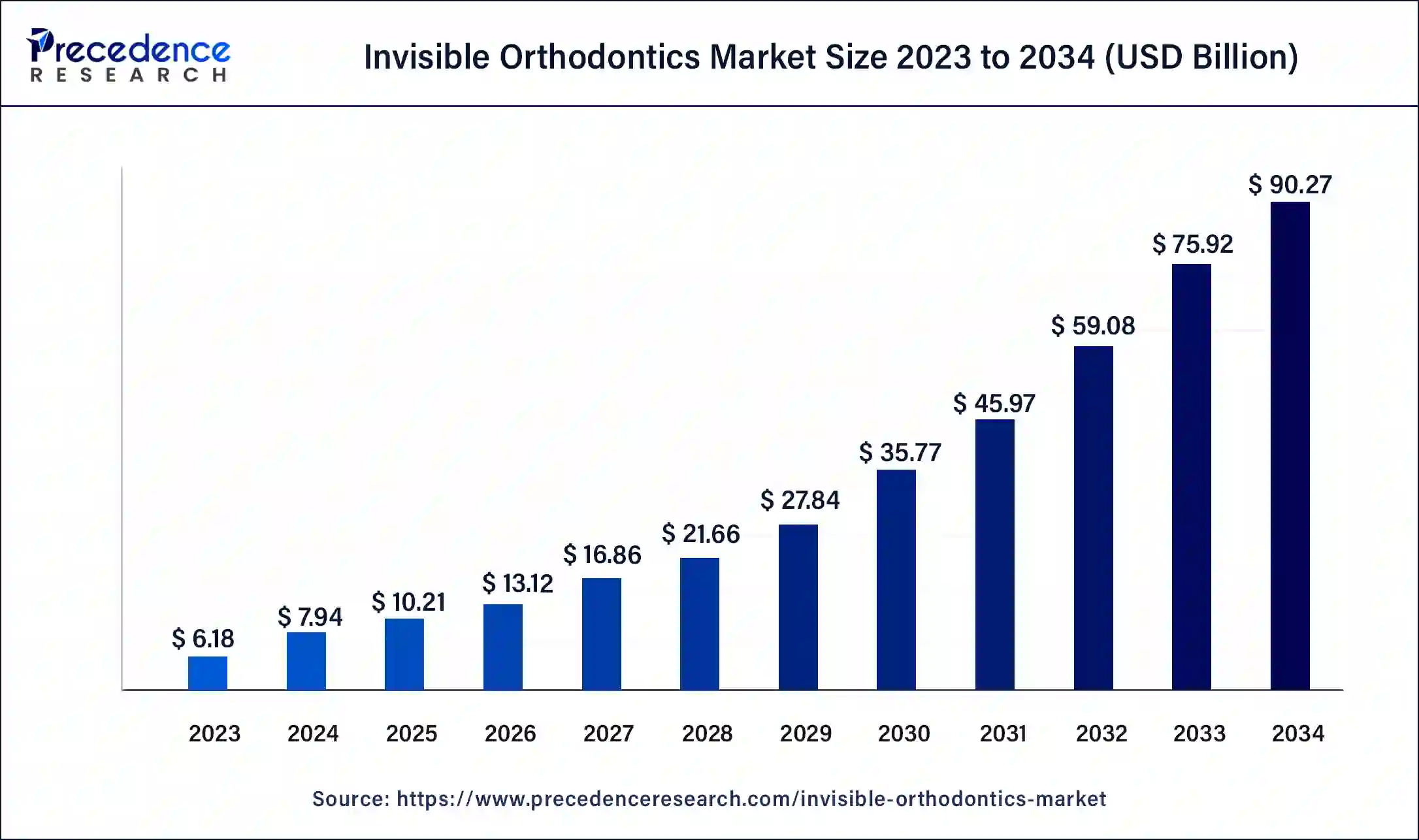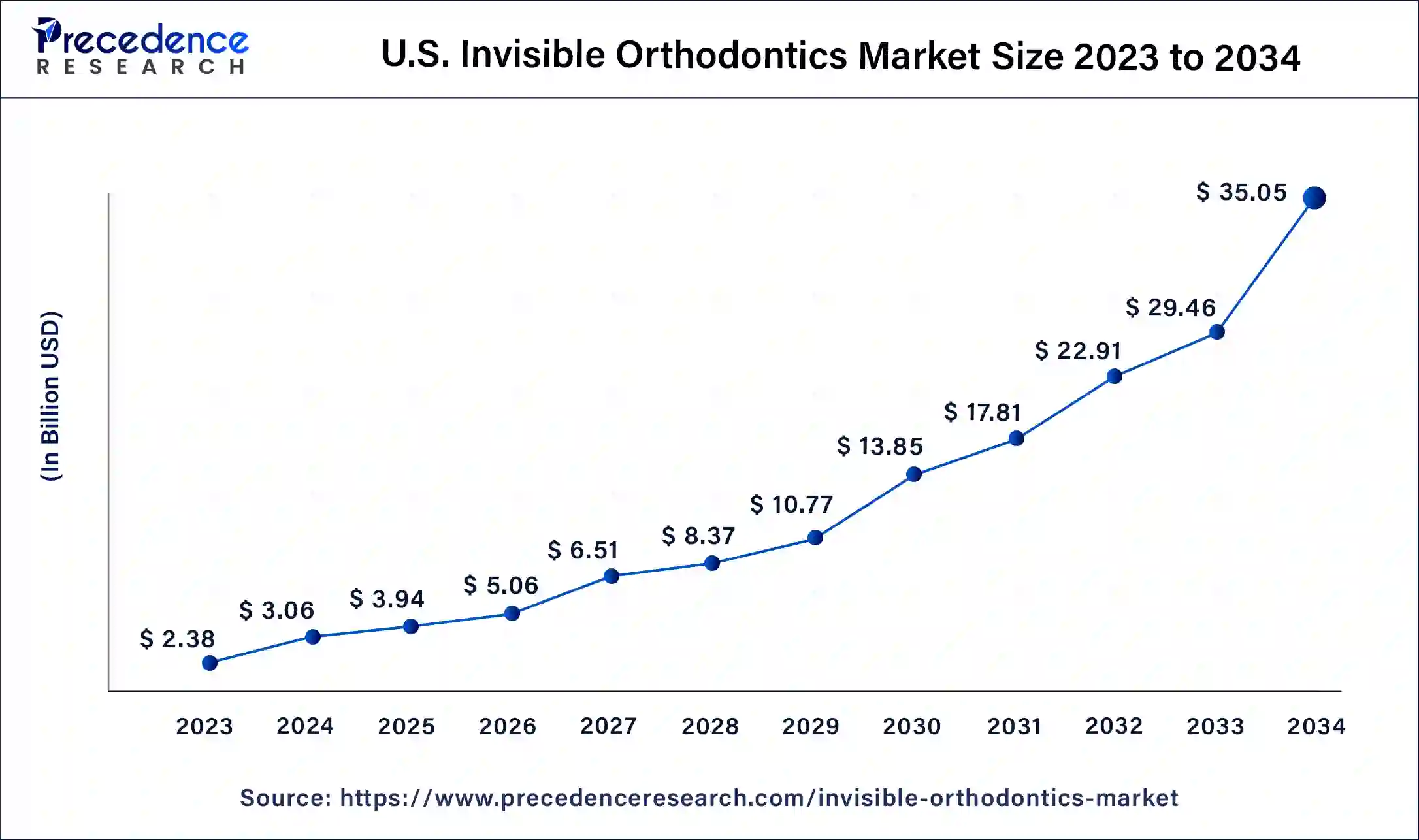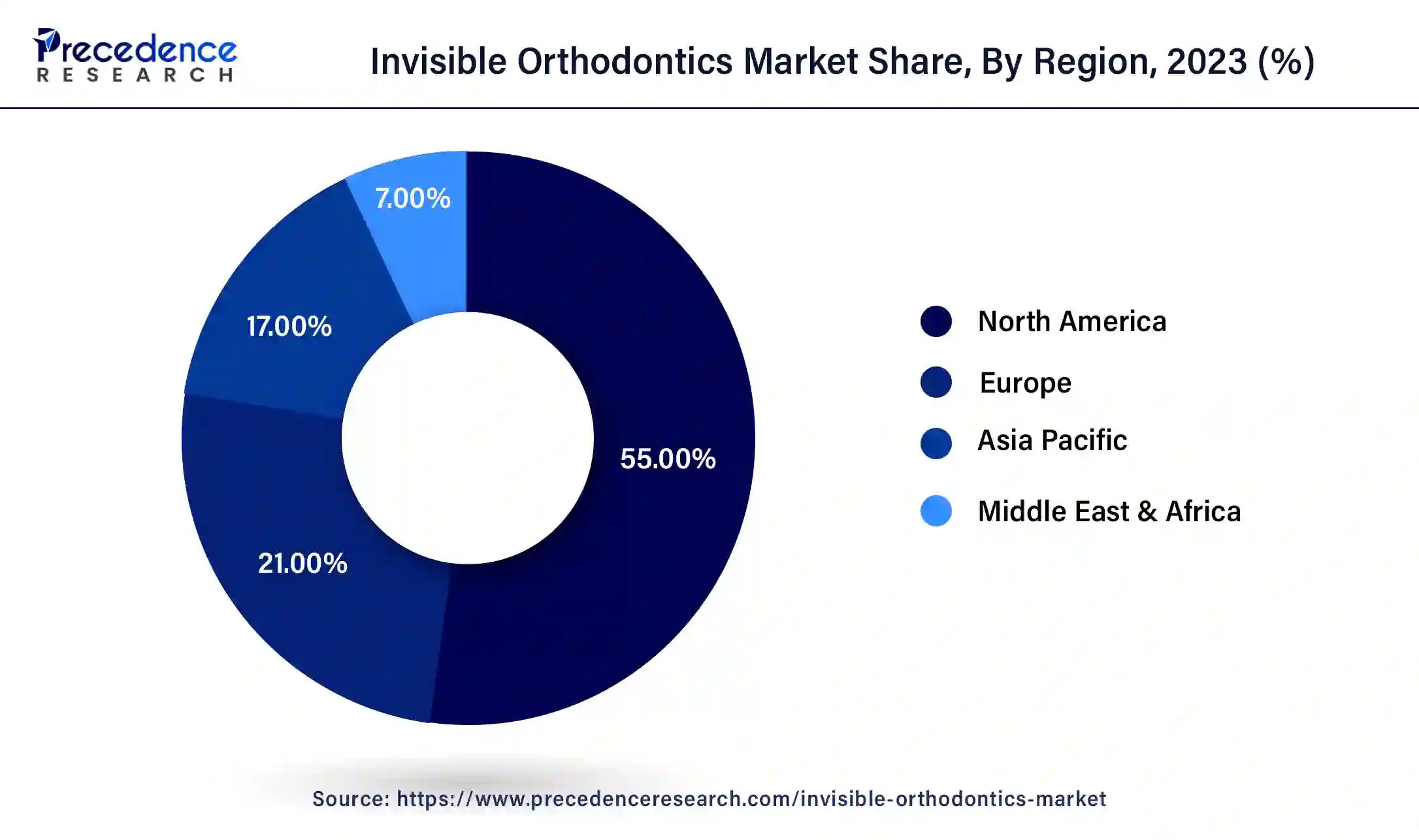Invisible Orthodontics Market Size and Companies
The global invisible orthodontics market size accounted for USD 7.94 billion in 2024 and is predicted to reach around USD 90.27 billion by 2034, growing at a CAGR of 27.52% from 2024 to 2034. Growing demand for invisible orthodontics and rapid technological advancements in dental health tailored for adults and teenagers are raising the demand of the market globally.

Invisible Orthodontics Market Key Takeaways
- The global invisible orthodontics market was valued at USD 7.94 billion in 2025.
- It is projected to reach USD 75.92 billion by 2034.
- The market is expected to grow at a CAGR of 27.52% from 2025 to 2034.
- The global invisible orthodontics market was valued at USD 7.94 billion in 2024.
- It is projected to reach USD 90.27 billion by 2034.
- The market is expected to grow at a CAGR of 27.52% from 2025 to 2034.
- North America led the market with the largest market share of 55% in 2024.
- Asia Pacific is showcasing significant growth in the market.
- By product, the clear aligners segment has heled the largest market share of 85% in 2024.
- By product, the ceramic braces segment is expected to show significant growth in the upcoming years.
- By age group, the adult segment accounted for the highest market share of 60% in 2024.
- By age group, the teenager segment is anticipated to show the fastest growth over the forecasted period.
- By end use, the stand alone practice segment dominated the market in 2024.
- By end use, the hospital segment is predicted to register the fastest growth in the foreseeable future period.
- By dentist type, the orthodontists segment was estimated to hold the highest share of the market in 2024.
- By dentist type, the general dentists segment is expected to grow at a significant CAGR during the foreseen period.
U.S. Invisible Orthodontics Market Size and Growth 2025 to 2034
The U.S. invisible orthodontics market size was estimated at USD 3.06 billion in 2025 and is predicted to be worth around USD 35.05 billion by 2034, at a CAGR of 27.62% from 2025 to 2034.

North America held the largest share of the global invisible orthodontics market. The region has high adoption rates and advanced healthcare infrastructure drives. The United States leads the region with the largest market share, fueled by strong demand for invisible orthodontic treatments among adults and teenagers seeking aesthetic solutions. Similarly, Canada follows closely behind, experiencing steady growth in the market due to increasing awareness and accessibility to orthodontic care.
- In February 2022, OraPharma launched the OraFit custom clear aligner system in the United States. The OraFit aligner system uses high-performance materials in a three-layer design for improved aesthetics, more comfortable aligners, and overall long-term oral health.
- In September 2022, the Government of Canada stated that a third of Canadians currently do not have dental insurance. For this, the government committed to providing dental care for uninsured Canadians with a family income of less than USD 90,000 annually, starting with children under 12 years old in 2022.
Asia Pacific is showcasing significant growth in the invisible orthodontics market. The growth rate is attributed to factors such as rising disposable income, increasing awareness of dental aesthetics, and a large population base. Countries like China, Japan, and India are witnessing significant growth in the adoption of invisible orthodontic treatments, driven by urbanization, improving healthcare infrastructure, and changing consumer preferences.
- In October 2022, Direct-to-consumer dental-tech startup Snazzy, an India-based start-up, launched new technology that delivers complete aligner treatment. The Hyderabad-based company released what it claims is India's first Scan Box and Monitoring App. Offered free of charge to dental clinics upon registration, the app is said to deliver a complete aligner treatment to their patients with the aim of ensuring full patient compliance.

Additionally, Southeast Asian countries such as Singapore, Malaysia, and Thailand are emerging as key markets for invisible orthodontics, supported by growing dental tourism and a rising middle-class population seeking advanced dental treatments. As the demand for aesthetic orthodontic solutions continues to rise across the region, it is expected to become a prominent growth engine for the global invisible orthodontics market in the coming years.
Market Overview
The invisible orthodontics market has seen exponential growth in recent years, driven by increasing demand for discreet teeth alignment solutions. With a focus on aesthetic appeal and convenience, invisible orthodontic treatments such as clear aligners have gained significant traction among both adolescents and adults. Market players are innovating with advanced technologies like 3D printing and digital scanning to customize treatments and improve efficiency.
The growing awareness of the benefits of orthodontic treatment for oral health and confidence enhancement has expanded the consumer base. The invisible orthodontics market is witnessing intense competition among key players, leading to aggressive marketing strategies and product developments to capture market share. Factors such as rising disposable income, changing lifestyles, and the influence of social media on beauty standards further drive market expansion.
However, challenges such as high treatment costs and limited insurance coverage in some regions may impede market growth to some extent. Overall, the invisible orthodontics market is poised for continued expansion as technological advancements and consumer preferences evolve.
Growth Factors
- An Increasing consumer demand for discreet teeth alignment solutions.
- Advancements in technology such as 3D printing and digital scanning.
- Growing awareness of the benefits of orthodontic treatment for oral health and confidence.
- Expanding consumer base, including adolescents and adults.
- Intense competition among key market players driving innovation.
- Aggressive marketing strategies to capture market share.
- Product developments catering to evolving consumer preferences.
- Rising disposable income facilitating affordability of treatments.
- Changing lifestyles influencing the desire for aesthetic dental solutions.
- Influence of social media on beauty standards promoting orthodontic treatments.
- Continual technological advancements were enhancing treatment efficiency and effectiveness.
Market Scope
| Report Coverage | Details |
| Growth Rate from 2025 to 2034 | CAGR of 27.52% |
| Global Market Size in 2025 | USD 7.94 Billion |
| Global Market Size by 2034 | USD 90.27 Billion |
| Largest Market | North America |
| Base Year | 2024 |
| Forecast Period | 2025 to 2034 |
| Segments Covered | Product, Age, End-use, Dentist Type, and Region |
| Regions Covered | North America, Europe, Asia-Pacific, Latin America, and Middle East & Africa |
Market Dynamics
Driver
Customize treatments
The primary driver fueling the growth of the invisible orthodontics market is the continuous advancement in technology coupled with the ability to customize treatments. Innovations such as 3D printing and digital scanning have revolutionized the orthodontic industry, as have customized clear aligners tailored to each patient's unique dental structure. This customization not only enhances treatment effectiveness but also improves patient comfort and satisfaction.
Furthermore, technological advancements have streamlined the treatment process, reducing the time required for orthodontic procedures and making them more accessible to a wider range of consumers.
- In December 2022, Henry Schein, Inc. announced a partnership with the Biotech Dental Group. Together, they will bring Biotech Dental's full line of high-quality software, products, and services, including dental prostheses, clear aligners, dental implants, regenerative solutions, and biomaterials, to more dentists and dental laboratories and new geographies.
Restraint
High cost of treatment
Despite the growing demand for invisible orthodontic treatments, one significant restraint facing the invisible orthodontics market is the high cost of treatment coupled with limited insurance coverage in some regions. The expenses associated with invisible orthodontics, including consultation fees, treatment costs, and follow-up appointments, can pose a financial barrier for many prospective patients.
Additionally, limited insurance coverage for orthodontic procedures may deter individuals from seeking treatment or lead them to opt for less costly alternatives. This disparity in affordability could hinder market growth, particularly in regions with lower income levels or inadequate insurance coverage, as it restricts access to invisible orthodontic treatments for a significant portion of the population.
Opportunity
Conscious consumers with aesthetics
An emerging opportunity for the invisible orthodontics market lies in the growing acceptance and adoption of these treatments among older adults. Traditionally, orthodontic treatments were predominantly associated with teenagers only. However, there is a shifting trend towards adults seeking orthodontic solutions to improve both oral health and aesthetics. As the aging population becomes increasingly conscious of their appearance and dental health, there is a substantial market opportunity for invisible orthodontic treatments tailored to the specific needs and preferences of older adults.
Market players can capitalize on this trend by developing targeted marketing campaigns and specialized treatment options tailored to address the unique concerns of older adult patients, thereby expanding their consumer base and driving market growth. Also, educating older adults about the benefits of invisible orthodontic treatments for oral health and overall well-being can further stimulate demand and expansion of the invisible orthodontics market.
- In July 2022, Sage Dental entered a partnership with SheepMedical, Japan's leading clear aligner manufacturer, and became the first DSO in the United States to offer KiyoClear orthodontic aligners. KiyoClear's patented aligner-expander technology.
Product Insights
The clear aligners segment dominated the invisible orthodontics market in 2023. These transparent, removable trays gradually shift teeth into alignment, catering to individuals seeking a more aesthetically pleasing orthodontic solution. Clear aligners boast advantages such as ease of use, minimal impact on daily activities, and virtually invisible appearance, which are some factors that appeal to a wide range of patients, including adults and teenagers. Hence, major key players are investing in building a clear alignment with maximum benefits and comfort for consumers.
- In November 2022, Ormco Corporation launched Spark Clear Aligners Release 13 to enhance treatment planning and efficiency. Hence, the launch of advanced and novel clear aligner products leads to a surge in their demand. Thus, with such an advancement in technology and increasing consumer demand for inconspicuous orthodontic treatments, the clear aligners segment is poised for continued growth and market dominance.
In the invisible orthodontics market, the ceramic braces segment is expected to show significant growth in the upcoming years. While the segment showcases significant growth and is anticipated to be further fostered in the upcoming years, these braces blend with the natural color of teeth, offering a more discreet alternative to traditional metal braces. Ceramic braces appeal to patients who desire a less noticeable orthodontic treatment option while still achieving effective teeth alignment. With improvements in ceramic material technology, these braces now offer enhanced durability and reduced visibility. As consumer awareness and demand for less conspicuous orthodontic solutions continue to rise, the ceramic braces segment is expected to experience rapid growth and significant market expansion.
Age Group Insights
The adult segment accounted for the highest share of the invisible orthodontics market in 2024. Adults increasingly prioritize aesthetics and convenience when considering orthodontic options, driving demand for invisible orthodontic solutions such as clear aligners. Factors such as improved technology, shorter treatment times, and the desire for a more discreet option contribute to the popularity of invisible orthodontics among adults. Additionally, the societal acceptance of adult orthodontic treatment has further fueled the growth of this segment, as adults seek to improve their smiles and oral health without the stigma associated with traditional braces.
The teenager segment is anticipated to show the fastest growth in the invisible orthodontics market over the forecasted period. Teenagers represent a significant portion of orthodontic patients, with many seeking treatments for aesthetic reasons or to address dental issues during adolescence. Clear aligners, with their discreet appearance and removable nature, appeal to teenagers who desire orthodontic treatment without the visibility and discomfort of traditional braces. As awareness and acceptance of invisible orthodontic options grow among teenagers and their parents, this segment is expected to continue expanding in the coming years.
End-use Insights
The stand alone practice segment dominated the invisible orthodontics market in 2024. These standalone clinics offer patients a focused approach to orthodontic care, with specialized expertise and personalized treatment plans tailored to individual needs. Patients often prefer standalone clinics for their specialized knowledge, advanced technology, and dedicated focus on orthodontic treatments.
- In July 2023, Angel Aligner launched custom-made, clear aligners and aligner technology into the U.S. market, with a strong emphasis on patient satisfaction and results. Also, standalone clinics have established themselves as leaders in the invisible orthodontics market, attracting a loyal patient base and driving significant revenue growth in the industry.
The hospital segment is predicted to register the fastest growth in the foreseeable future period. Hospitals are increasingly incorporating invisible orthodontic treatments into their services, offering patients a comprehensive range of orthodontic options under one roof. This trend is fueled by the growing recognition of the importance of oral health within the broader healthcare landscape and the desire to provide patients with convenient access to advanced orthodontic treatments. With hospitals investing in state-of-the-art technology and skilled orthodontic professionals, the hospital segment is poised for significant growth in the market, catering to a diverse patient population seeking high-quality orthodontic care in a medical setting.
Dentist Type Insights
The orthodontists segment was estimated to hold the highest share of the invisible orthodontics market in 2024. The growth of this segment is owing to their specialized training and expertise in orthodontic treatments. Orthodontists possess advanced knowledge and skills specifically focused on correcting dental misalignments and bite issues, making them the preferred choice for patients seeking invisible orthodontic solutions.
With their specialized training and experience, orthodontists offer patients personalized treatment plans and comprehensive care throughout the orthodontic journey, ensuring optimal results and patient satisfaction. Their prominence in the market underscores the importance of specialized orthodontic expertise in delivering effective and high-quality invisible orthodontic treatments.
The general dentists segment is expected to grow at a significant CAGR in the invisible orthodontics market during the foreseen period. General dentists, while not specialized in orthodontics, are increasingly incorporating invisible orthodontic treatments into their practices to meet the growing demand for aesthetic orthodontic options. With advancements in clear aligner technology and training programs, general dentists are expanding their scope of services to include orthodontic treatments, offering patients a convenient and familiar setting for invisible orthodontic care. This trend reflects the evolving landscape of dental care, with general dentists playing a significant role in providing accessible and comprehensive orthodontic solutions to patients.
Recent Developments
- In February 2023, SmileDirectClub launched a CarePlus, a new premium aligner treatment. It offers a flexible design that helps customers manage and start aligner care in-person or remotely.
- In April 2023, Henry Schein, Inc. held the acquisition of a majority ownership stake in Biotech Dental, a provider of clear aligners, dental implants, and digital dental software.
- In March 2022, Align Technology, Inc. Introduced the new Cone Beam Computed Tomography (CBCT) integration feature for ClinCheck digital treatment planning software. This feature helps doctors consciously expand diagnosis and treat a broader range of cases. It is possible to use Invisalign clear aligners to increase visibility and handle a patient's underlying anatomical structures during the digital treatment planning process.
- In May 2022, Align Technology, Inc. Made an agreement with Asana, Inc., a leading work management platform for teams. The strategic partnership will offer Invisalign-trained doctors in the U.S. a new workflow solution, Asana SmilesTM for Align.
Invisible Orthodontics Market Companies
- Angel Aligner
- SmarTee
- Dentsply Sirona
- Institut Straumann AG
- SCHEU DENTAL GmbH
- Ormco Corporation (Envista)
- Henry Schein, Inc.
- SmileDirectClub
- Align Technology, Inc.
- TP Orthodontics, Inc.
- K Line Europe GmBH
- 3M
- ClearPath Healthcare Services Pvt Ltd
- DB Orthodontics, Inc.
- G&H Orthodontics
- Orthodontics SDC
Segments Covered in the Report
By Product
- Clear Aligners
- Ceramic Braces
- Lingual Braces
By Age
- Teens
- Adults
By End-use
- Hospitals
- Stand-alone Practices
- Group Practices
- Others
By Dentist Type
- General Dentists
- Orthodontists
By Geography
- North America
- Asia Pacific
- Europe
- Latin America
- Middle East & Africa
For inquiries regarding discounts, bulk purchases, or customization requests, please contact us at sales@precedenceresearch.com
Frequently Asked Questions
Ask For Sample
No cookie-cutter, only authentic analysis – take the 1st step to become a Precedence Research client
 sales@precedenceresearch.com
sales@precedenceresearch.com
 +1 804-441-9344
+1 804-441-9344